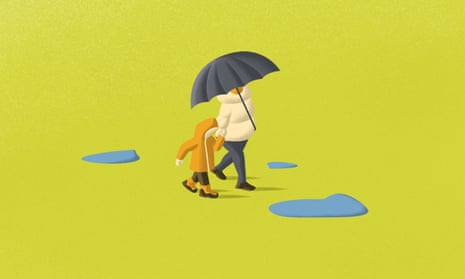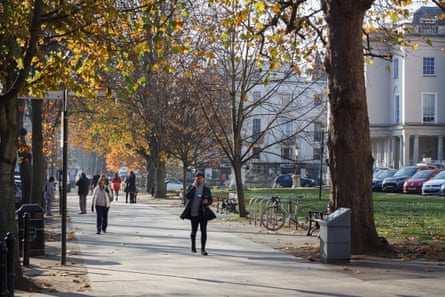Bad weather is good for you: take a walk in the wind and rain
Don’t be put off by winter weather – going out into the mud and cold is highly beneficial to our immunity and general health

In dozens of early letters, the artist Georgia O’Keeffe raved about walking in extreme wind. “I love it,” she wrote, again and again. A few other walkers have enthused about mud, snow, rain, darkness and cold. And yet, as the days draw in and the temperature falls, most of us hang up our walking boots.
Big mistake! In the last few years researchers have begun untangling some of the little-known benefits of walking in wintry conditions. It turns out that the conditions most deterring us from taking a stroll are, in fact, excellent reasons to step outdoors.
Cities are often at their most walkable in the winter, when wind disperses pollution, and rain washes the air of dirt and germs. A 2021 study found that the best days to avoid catching highly contagious strains of Covid were windy days, when germs and bacteria were instantly blown away. Cities empty quickly in the rain – meaning we can pick up our pace and stride along streets usually thronging with people.
Pavements devoid of pedestrians are also perfect for practising backwards walking – the latest trend to sweep Japan. A 2020 study published in Brain Communications found that reverse walking engages an entirely different set of lower body muscles. Walking backwards also improves our balance and stability. Normally we lean slightly forward when we walk but, in reverse, our spine is nudged into alignment and our core has to work harder to keep us stable. Another study found that 10 minutes of backwards walking four times a week reduced lower back pain after a mere three weeks. At the same time, we strengthen our knee joints and quadriceps – which means an improved gait and fewer aches and pains. A wide, flat, empty pavement is the ideal place to practise reverse walking.

If you’re in the country, a downpour is the perfect time to walk – but for quite different reasons. The pounding of raindrops causes plants, trees and soil to release sweet-smelling compounds which then mingle and combine in the air we breathe. The Scottish writer, Nan Shepherd, loved walking after rainfall, noting that birch trees released a perfume “fruity like old brandy”. Studies suggest that inhaling these compounds improves our mood, while the abundance of negative air ions – created as water and air molecules collide making a molecule with an extra charge – can improve respiratory health and immunity. When Austrian scientists ran a series of experiments in the Alps, they were stunned to find that participants walking in heavily ionised air had higher levels of a vital antibody located in the mucosal lining of the mouth, nose and gut. The researchers speculated that this bounteous antibody accounted for the participants’ strengthened immunity and amplified lung capacity.
So put on your wellies and a waterproof coat and take advantage of the purer air and the complex array of scents that accompany a downpour. Seek out mountains or forests, where negative air ions linger for longer. In misty woodlands, negative air ions are twice as abundant as on open land, so get up early and make the most of autumn’s final morning mists.
READ RELATED: Premier Inn took £226 from me even though there was no booking
If it’s a muddy forest, even better. Believe it or not, mud is a boon for your health. So rather than taking lengthy detours to avoid a stretch of quagmire, just walk right through it breathing deeply as you go. Mud – be it farmyard or forest floor – is rich in mood-enhancing microbes. Australian researchers found that mice exposed to soil had more diverse microbiomes, a finding mirrored by a Finnish study in which the gut and skin of children playing in plastic-and-concrete playgrounds were compared to those of children whose playground had been rebuilt using a tract of forest floor. In as little as four weeks, the children playing on forest floor had developed more diverse microbiomes. More importantly, the researchers found “parallel changes in the children’s immune systems”, with the muddy children showing greater immunity and fewer coughs and colds for months afterwards. Mud can be slippery, so use walking poles for stability. As you prod at the earth, you’ll also be releasing beneficial bacteria from the soil.
Cold weather is another excellent reason to walk, thanks to the way brown fat works. Brown fat (sometimes known as brown adipose tissue) gobbles up dangerous artery-clogging white fat. Brown fat is a more effective fat burner than anything else, which explains why thin people often carry generous supplies. And it’s activated by cold. Studies have found that Nordic construction workers and those who go bare-legged in winter have impressively rich layers of brown fat. You can shiver through a Wim Hof ice bath or you can go for a nippy walk with your coat undone at the collar and your scarf unwrapped. Exercise and caffeine also spur production of brown fat, so take a coffee.
There’s one more excuse I hear at this time of year: it’s too dark. Again, science has discovered plenty of reasons for an evening stroll. Not only does an after-supper walk control blood sugar levels (vital for diabetics) and help shunt food smoothly through the gut (meaning more efficient digestion and less constipation), but the dim evening light prompts our body to start making sleep-inducing melatonin.

A wet night is better still. According to Dr Kate McLean, an expert in urban scents and smells, damp nights enable us to uncover the world anew through our nose: “In darkness we alter our primary way of encountering the world, and when the air is damp it traps odour-causing molecules, transforming a dark, damp walk into a source of inspiration and imagination.”
So instead of binge-watching a box set, pull on your boots (making sure they’re watertight with good grip) and walk. One day, your body and brain will thank you.
Annabel Streets is the author of 52 Ways to Walk: The Surprising Science of Walking for Wellness and Joy, One Week at a Time (Bloomsbury 2022) and, writing as Annabel Abbs, Windswept: Why Women Walk (Two Roads 2021). to buy a copy of 52 Ways to Walk for £11.30, go to Guardian Bookshop.
Source: Health & wellbeing | The Guardian





